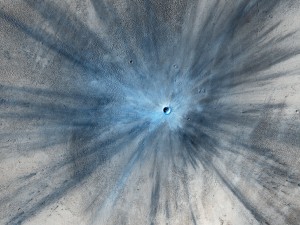
Figure 1 – A dramatic, fresh impact crater photographed by NASA’s Mars Reconnaissance Orbiter on Nov. 19, 2013. The last images of this region were taken in May 2012 and showed no crater. Image from NASA and in the public domain.
My friend Howard, who is an astrophysicist, recently posted on his Facebook page the image of Figure 1. It was taken by NASA’s Mars Orbiter and shows a new impact crater on the surface of the Red Planet. By now you know that I am a lover of the art form of these space images. I cannot help but marvel at these robotic eyes. There is so much wonderful technology in building them, in getting them there, and even in the ability to transmit high resolution images using next to no power the 35 to 250 million miles to Earth. It’s truly a marvelous invention of Man. And yes there is man or woman subtly omnipresent in the image. The composition, the choice of coloration, the delicate debris stream that radiates outward from the crater all bear the signature of artistically sensitive man. Science reunites with humanism a hundred million miles from Earth.
But in this particular image, I think that there is something more. The image is meant in this case to document change. This crater has appeared as if out of nowhere between May 2012 and November 2013. It is reminiscent of the jelly doughnut rock. There is geology at play on Mars as on Earth. The Martian terrain bears witness to the forces of change: water, ice, wind, and sun. We have already spoken of how rocks seem to grow over the winter in our lawns, driven, in fact, to trhe surface by a frost heave effect – that is by the expansion of ice when it freezes. Yes there are meteorite impacts that form craters that throw rocks, and there are volcanoes that spew rocks for hundreds of miles. The point is that geology is not static but all about change.
And it is a curious thing that photography that is the most precisely instantaneous and immutable of media is used, in so many instances, to bear witness to change. With the jelly doughnut rock and with this crater it is geological change that the photograph is documenting. But think of how much you enjoy leafing through old family photograph albums. The appeal is to see a precise sequence of insanely instantaneous moments that display the change in ourselves and in our families and friend. They make us smile, laugh, and even cry. “Time doth transfix the flourish set on youth…”
This is also, of course, part of the appeal of old photographs. Being black and white adds to the magic. Sepia toning is best at setting the mood of authenticity that “yes, this is an old object.” We love to look at old pictures. Our eyes strain to digest every instance of change. But is it really change that we are looking for? In old family photographs we gain satisfaction in familiarity. No matter how much younger you or your parents were, in the end, they really look like you. They really are you. And in the case of old photographs the appeal is ultimately in consistency. They were people like us. The clothes have changed – fashion does. I often focus on the neckties. But the places are ultimately the same – add a touch of nostalgia for a moment in time that you otherwise never experienced. And magically through the power of the photograph we realize that in the end they were – even are – just like us. Plus ça change, plus c’est la même chose.
